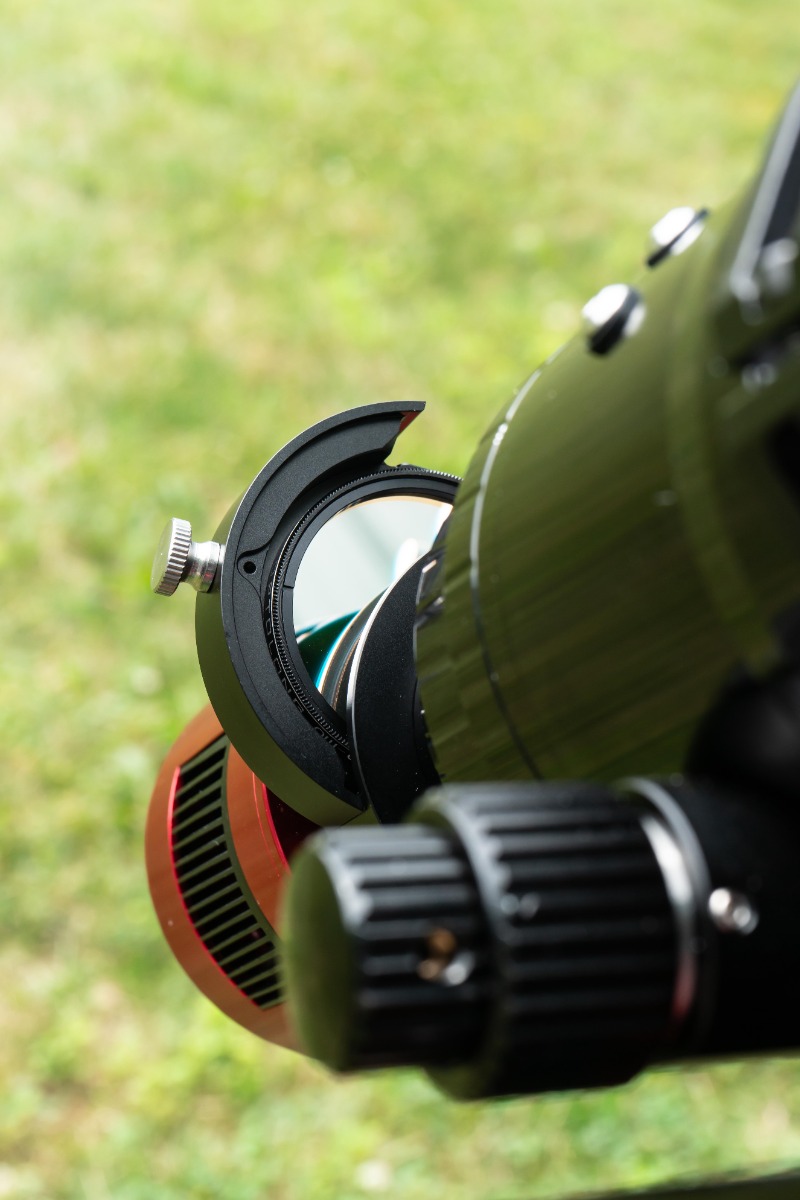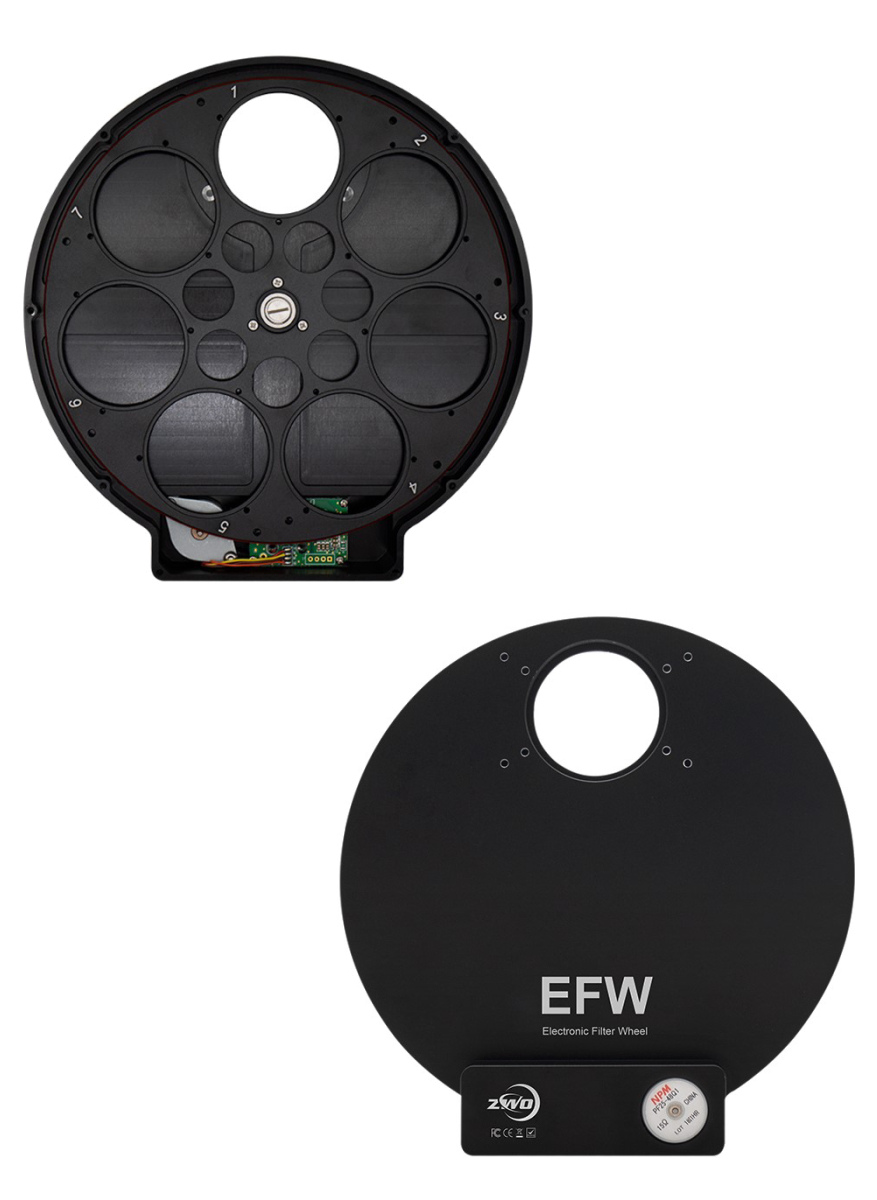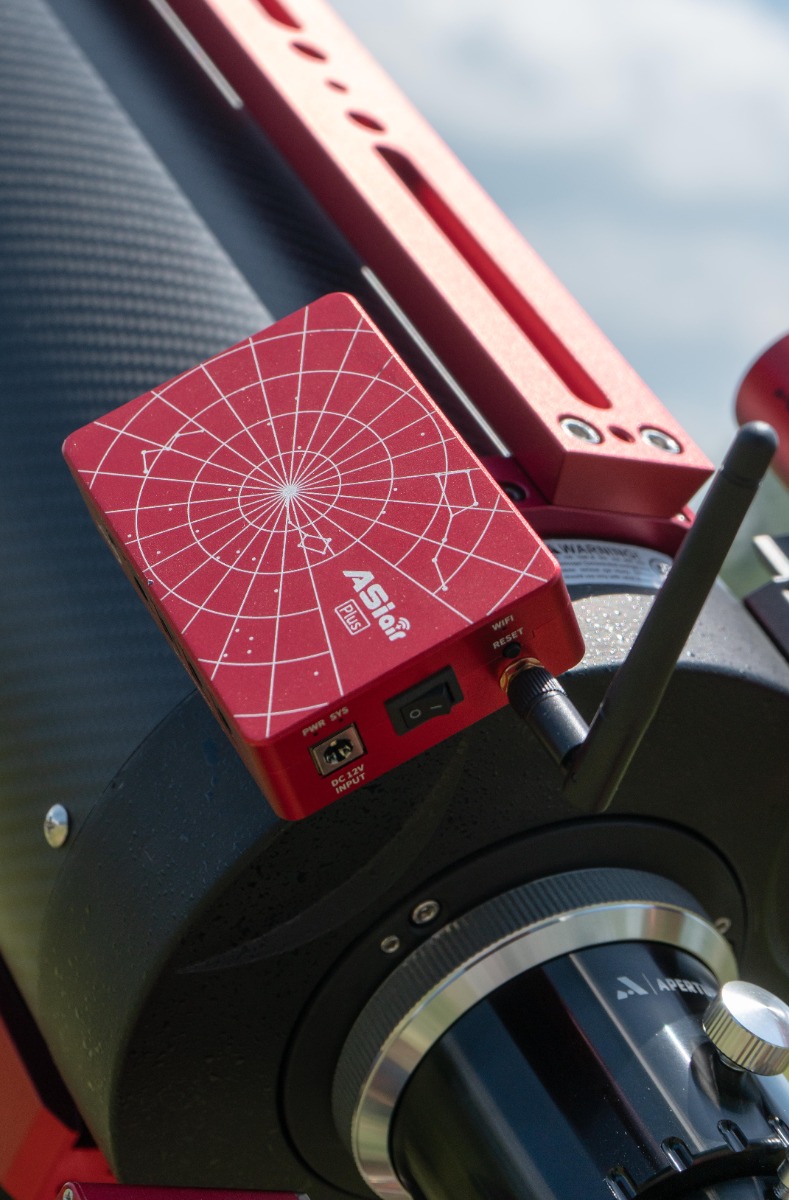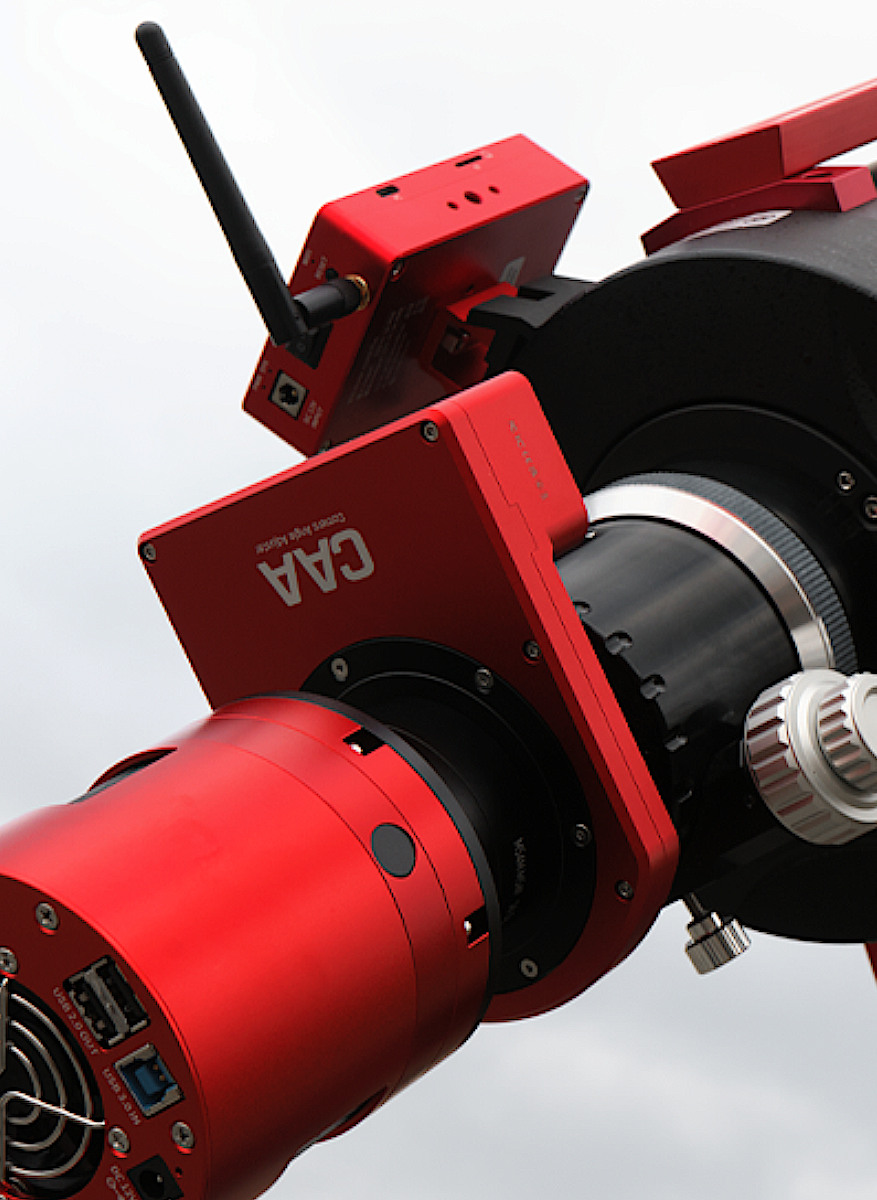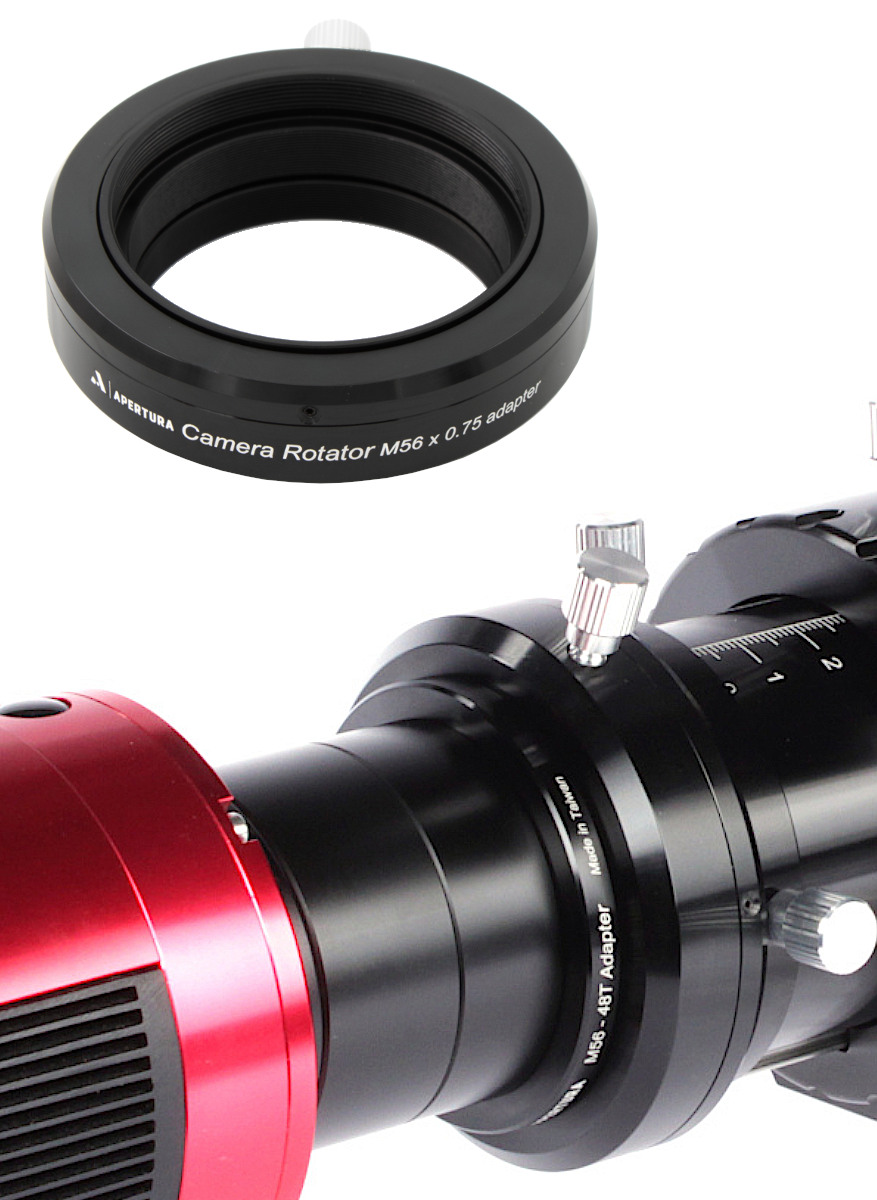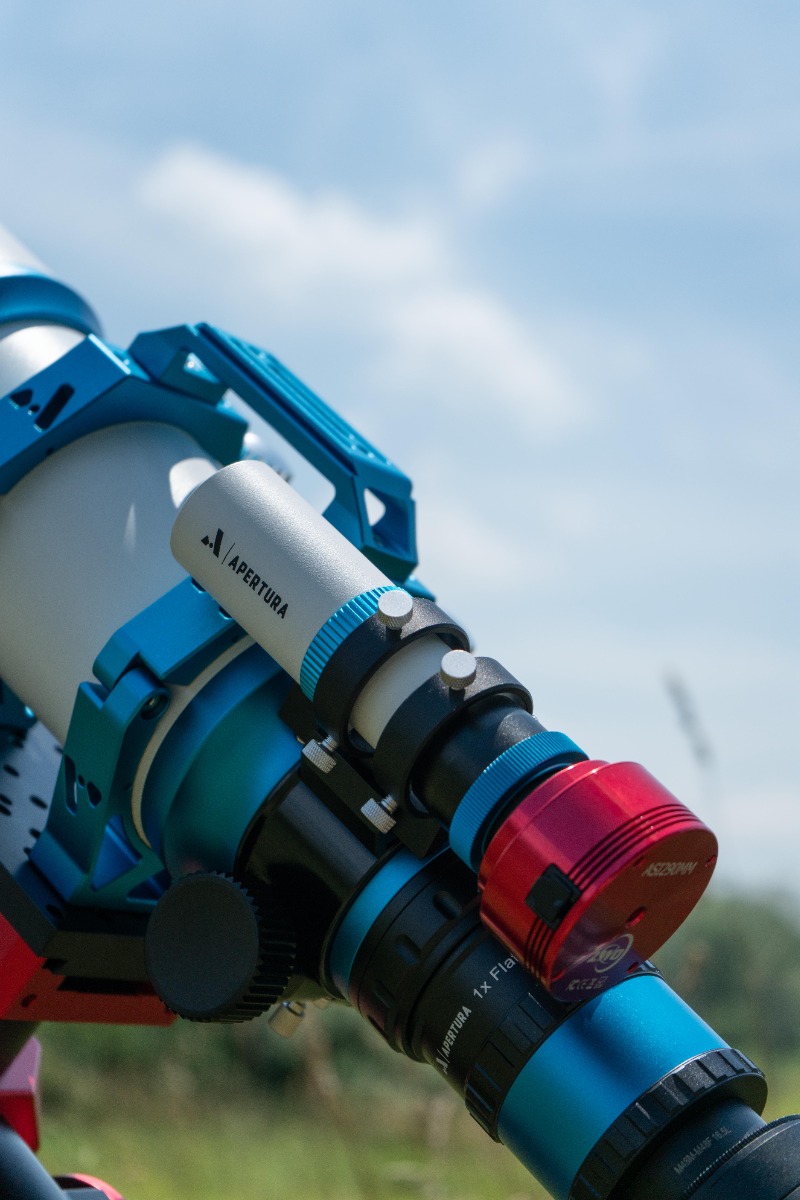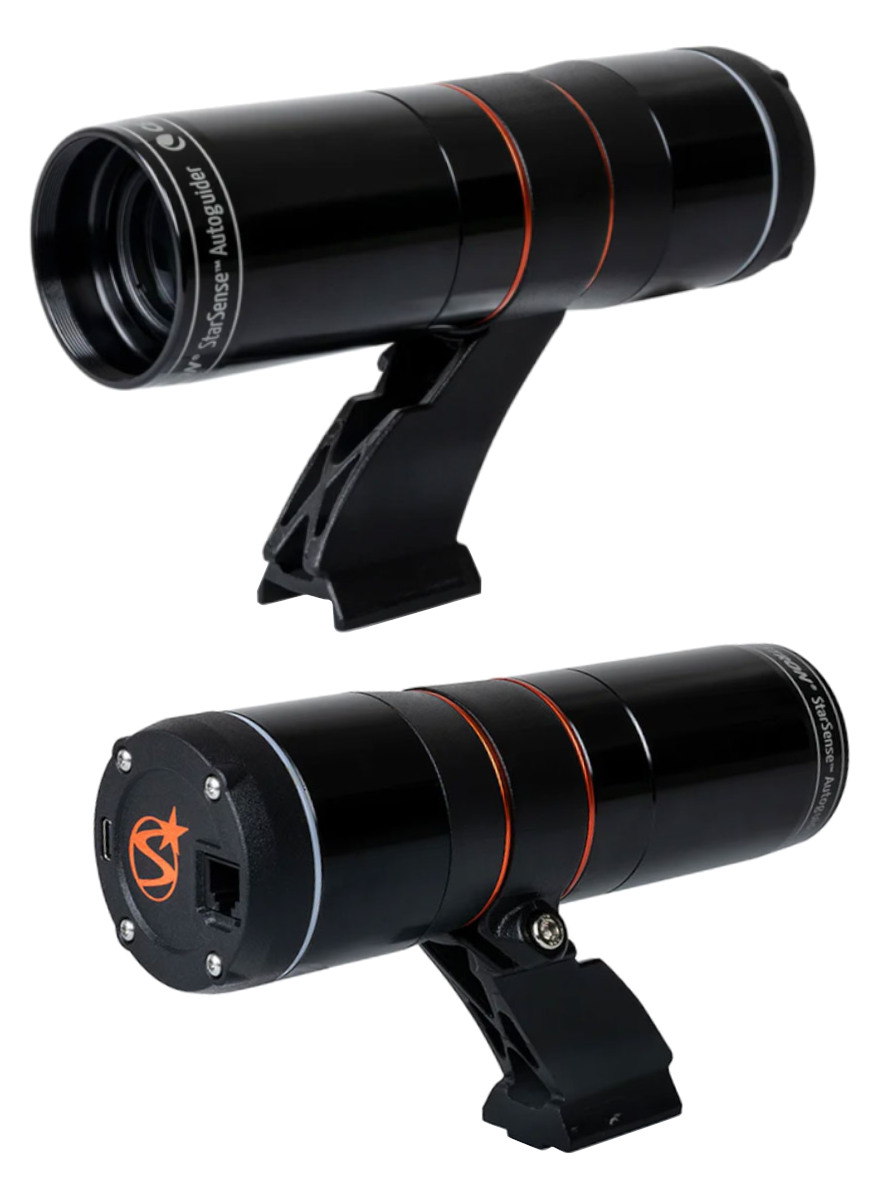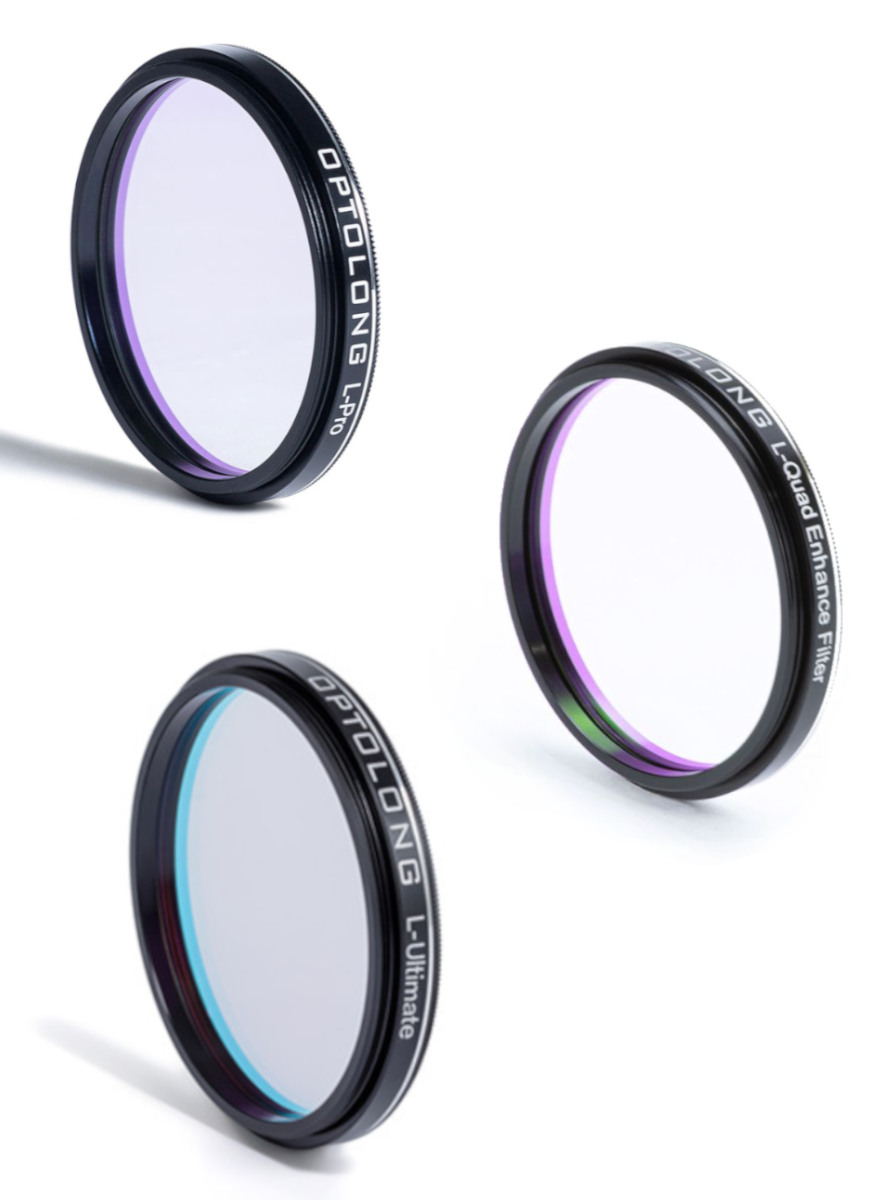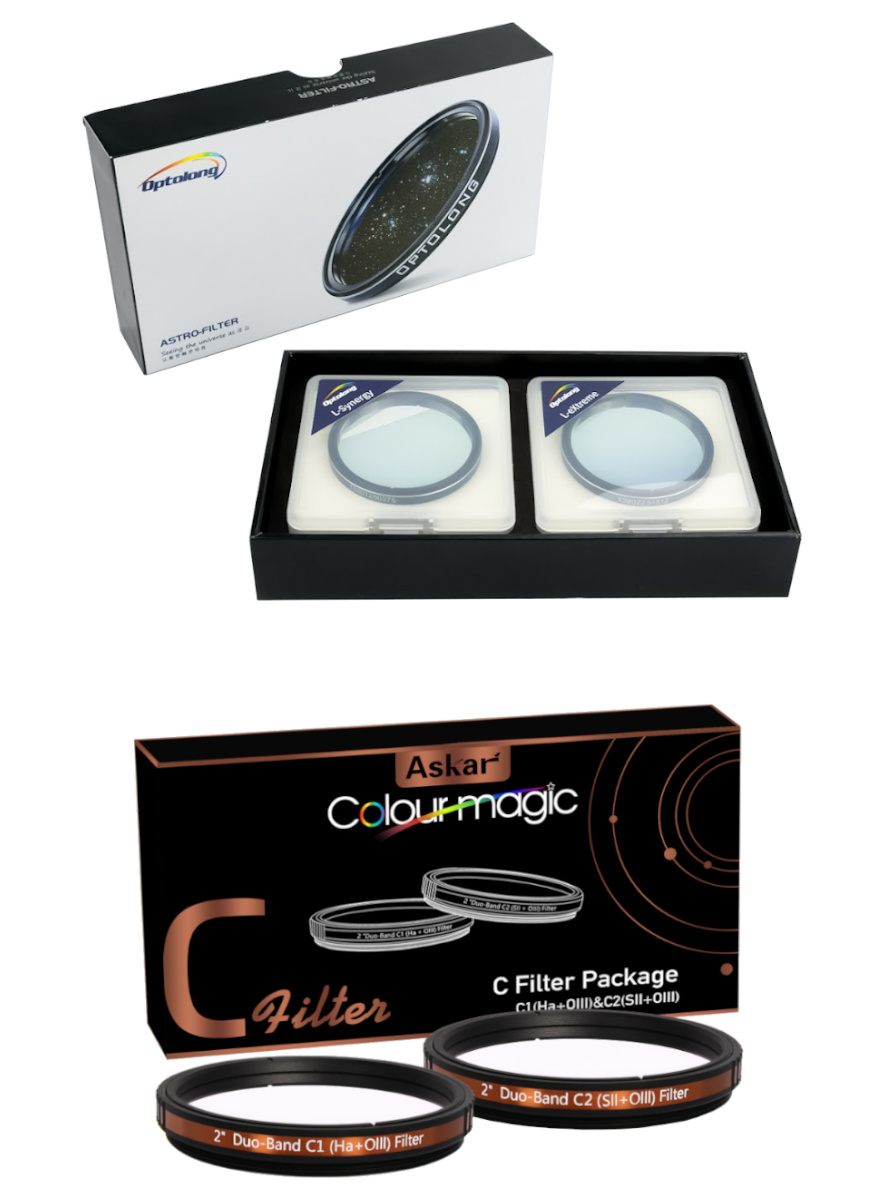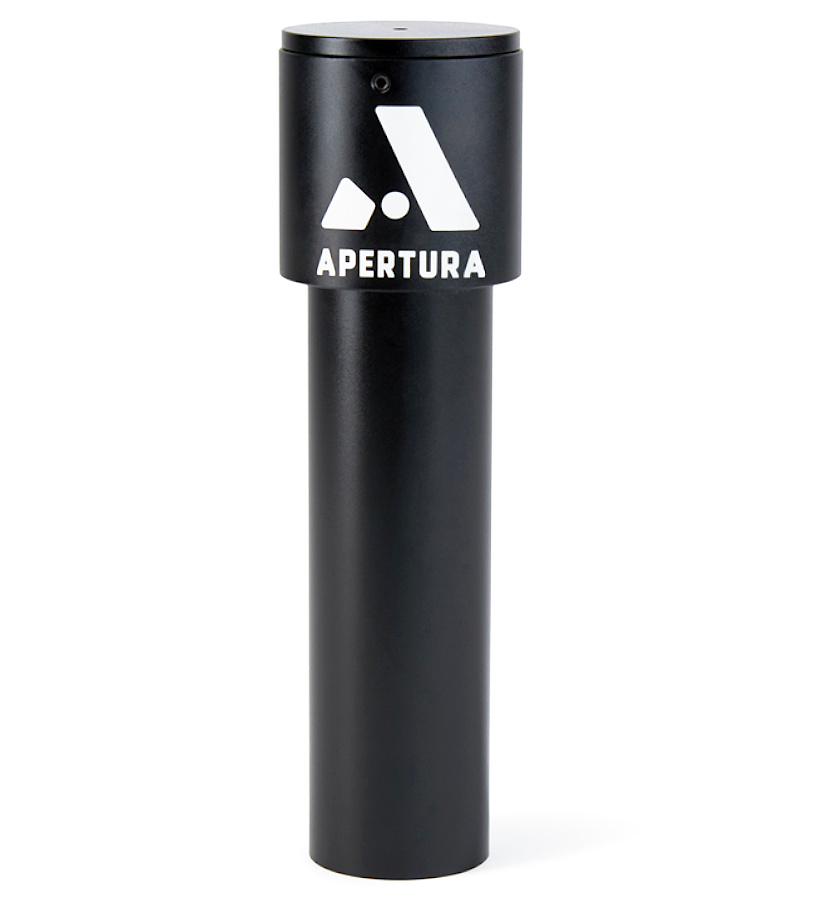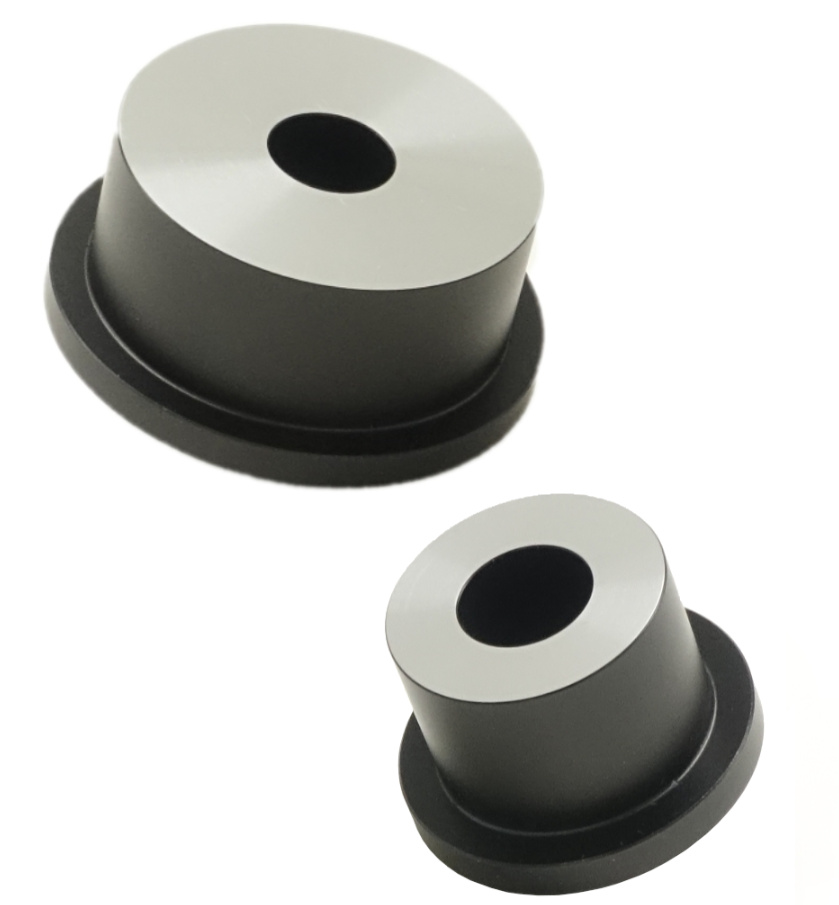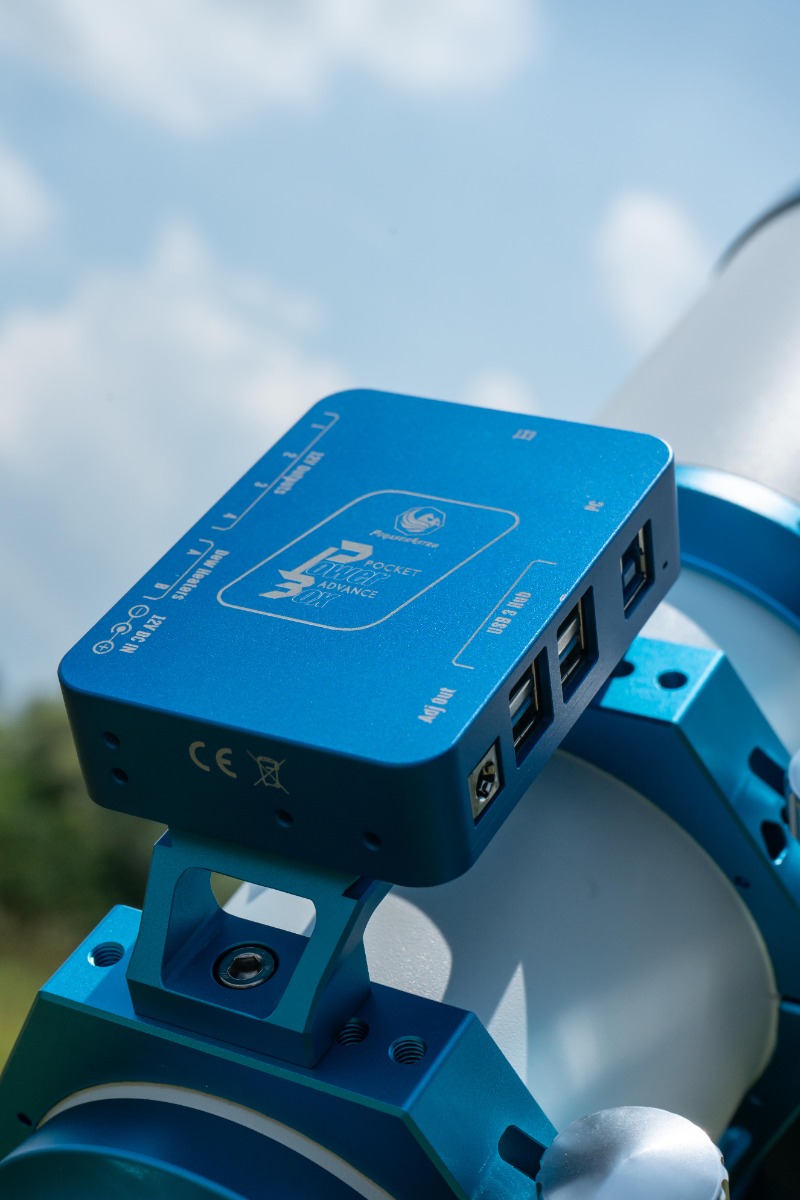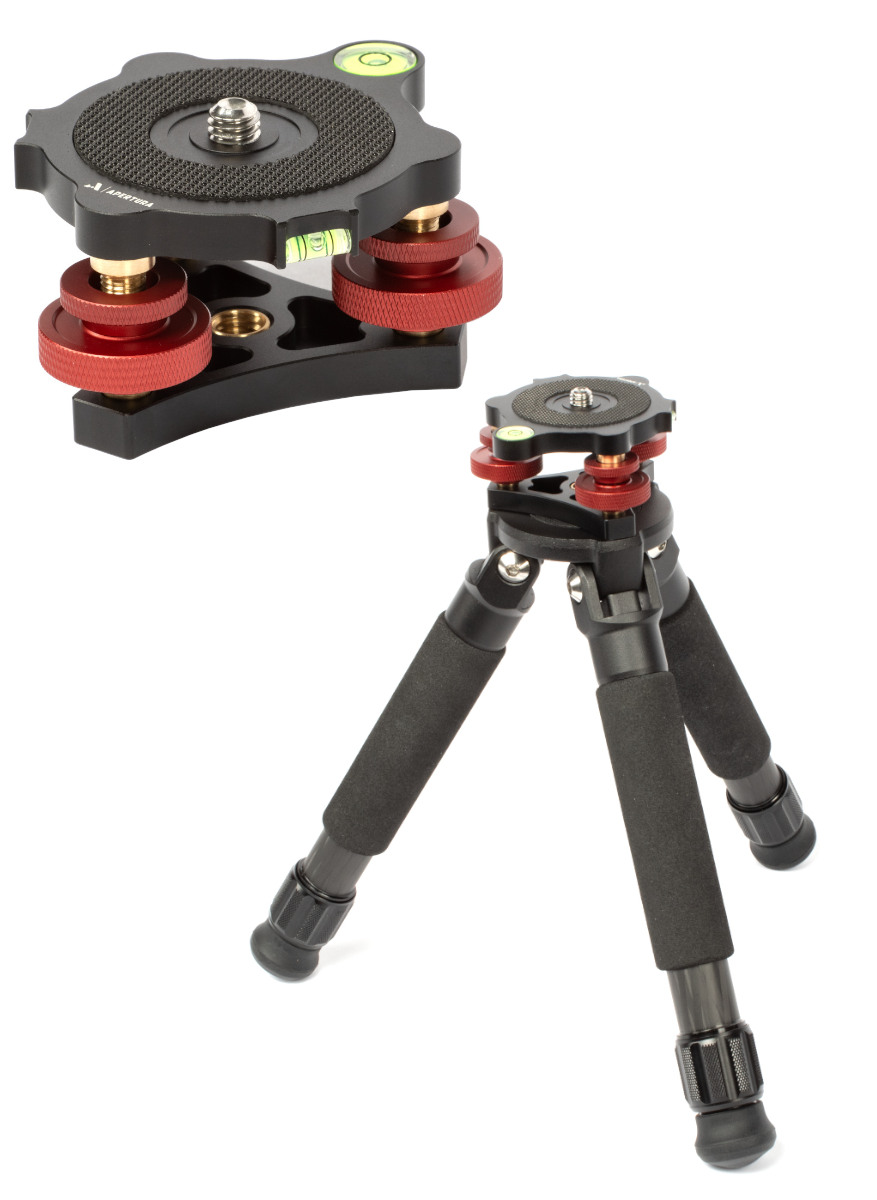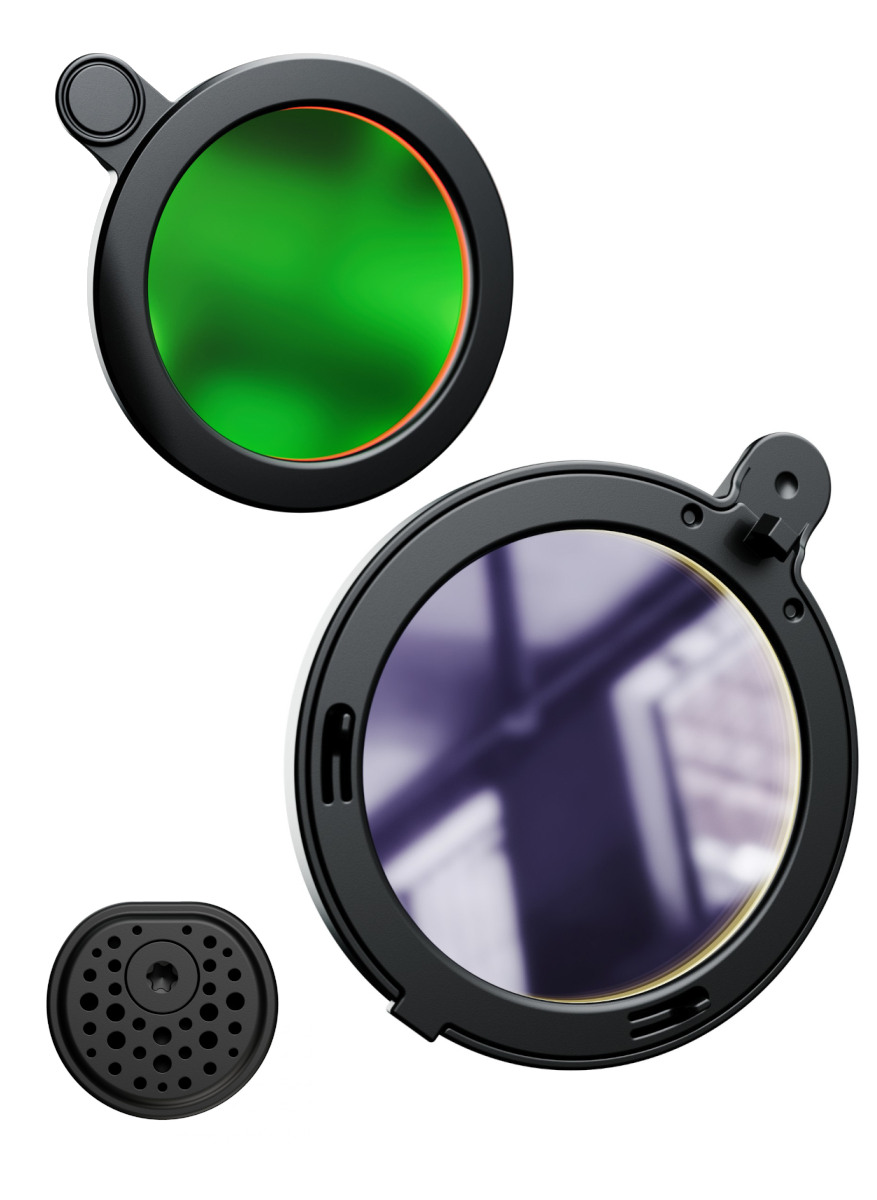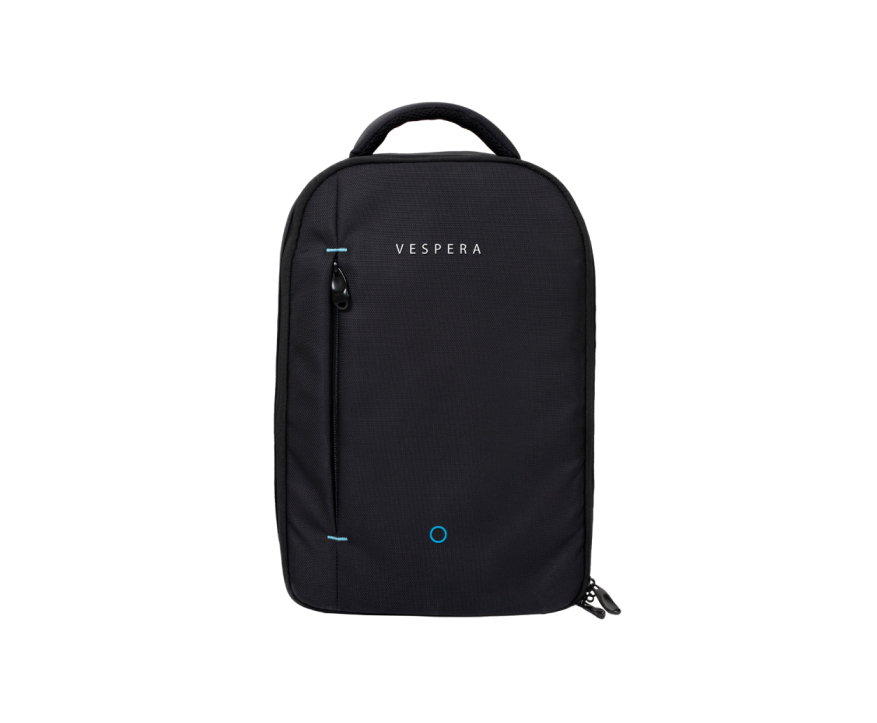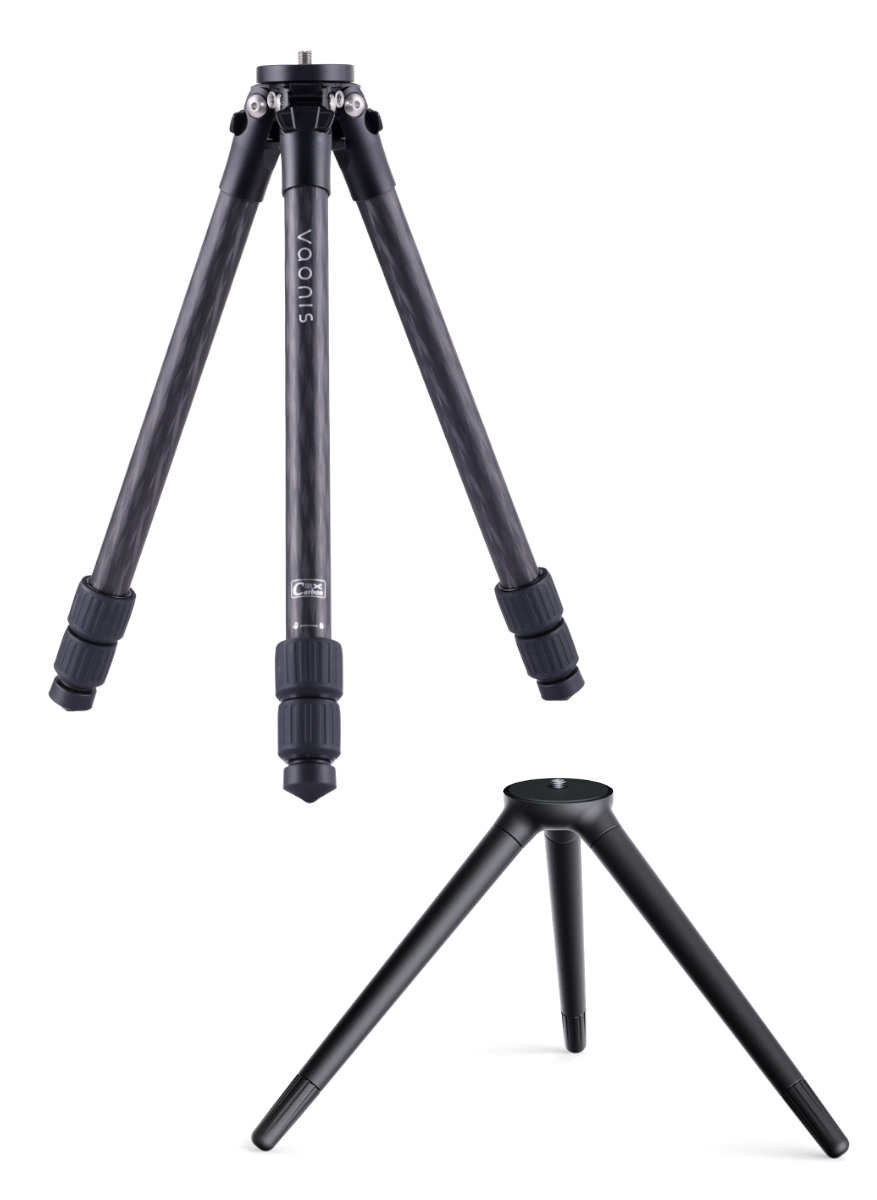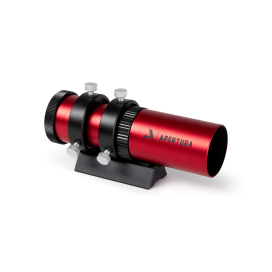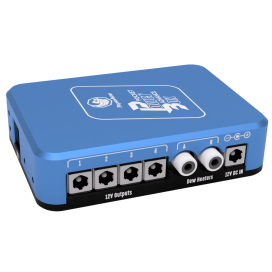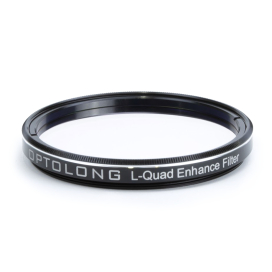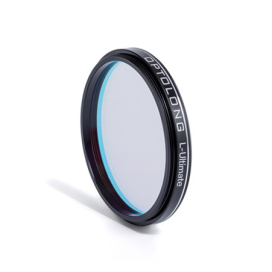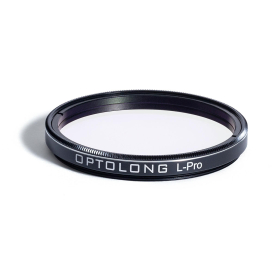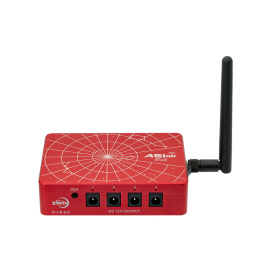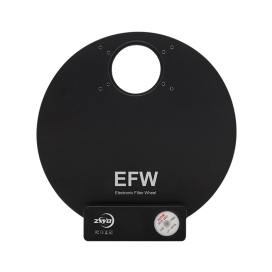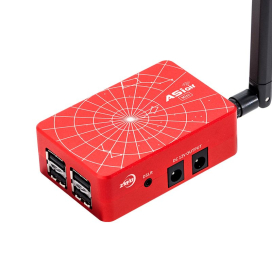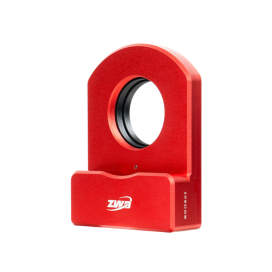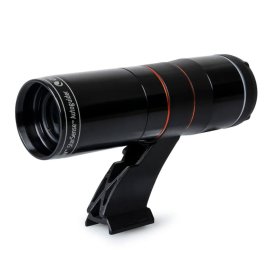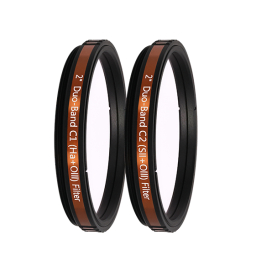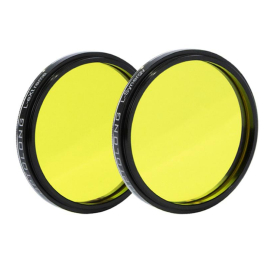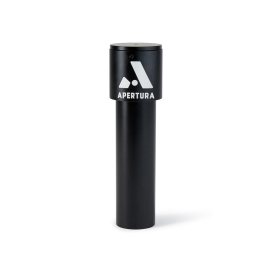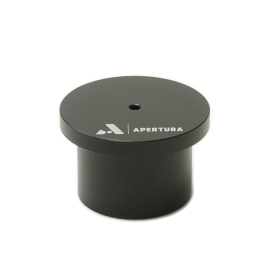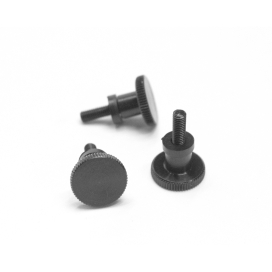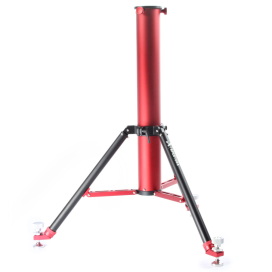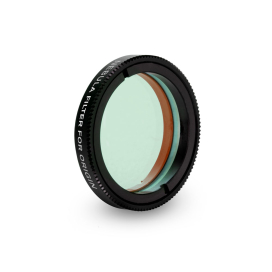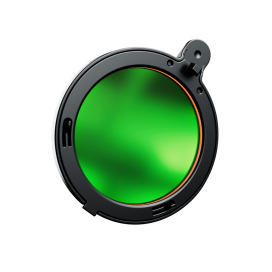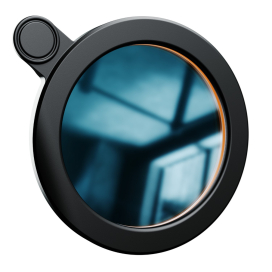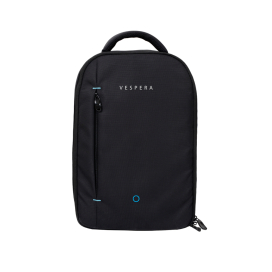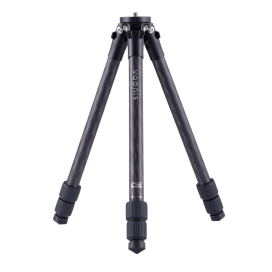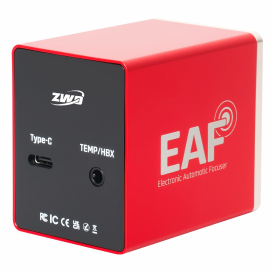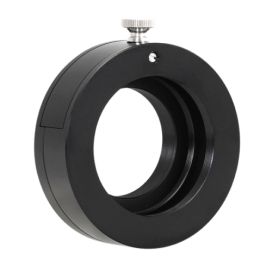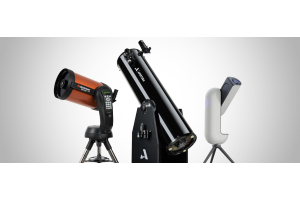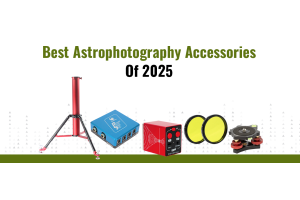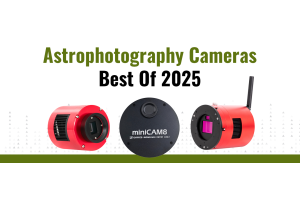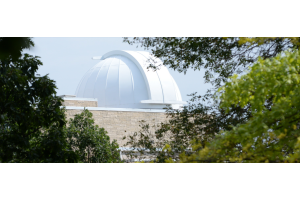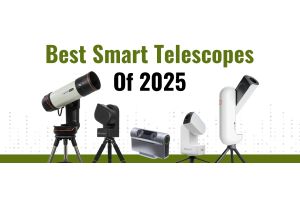
Table of Contents
Contents
With 2025 seeing a wealth of exciting add-ons released alongside the already vast selection of astrophotography accessories, we understand (and have experienced) the daunting feeling that can come when trying to build or upgrade your system. To make navigating the sea of stellar options a bit simpler, we've distilled our vast catalog down into some the best 'bang for your buck' accessories that will help your squeeze the most out of your imaging sessions and make them simpler. This curated list covers not just great complimentary gear for a traditional astrophotography build, but also the emerging smart telescope astrophoto category. So whether you're looking to enhance your hands off all-in-one smart scope or dial in a powerful telescope, mount, and camera build, read on!
Traditional Astrophotography Accessories
Electronic Focusers
ZWO Electronic Automatic Focuser (2025) -
All of the accessories covered in this article will greatly enhance your astrophotography experience, but taking the top spot of this list are electronic focusers as they truly are 'game changers.' While you can make finding tack sharp focus simple with something like the Apertura Bright Focus Mask line, an electronic focuser allows you to hone in on focus without needing to interact with the telescope at all. Simply engage the auto-focus function built into most of 2025's top software imaging suites or wireless control devices, and your scope will be ready for sharp shots in no time. These devices can also accept movement commands, allowing easily realize more control and precision in a manual/mask-assisted focus process. If you've looked into these incredible upgrades before it will likely come as no surprise that our pick for this year is the ZWO Standard Electronic Automatic Focuser (2025).
This is ZWO's revision of our top pick from last year, and while there are a number of other options hot on this focuser's heels the EAFN's incredible compatibility and great performance clinch its spot here. The EAF line set the standard for electronic focuser mounting that most telescopes (and competing options) currently available follow, making it likely you can pair this with your scope of choice (either natively or with a first/third party bracket). This extends to the realm of software as well, with the EAFN working with a wide range of programs and devices; including being only line of focusers officially supported by the monumental ASIAIR ecosystem. If you're looking for an upgrade on the tried-and-true EAF formula, we recommend this electronic focuser's big brother: the ZWO Standard Electronic Automatic Focuser (EAF) Pro. This adds manual focus control buttons, a built-in battery, and Bluetooth to the EAFN experience, allowing you to cut the cord from your ASIAIR and focus in situations where you don't necessarily want to boot up an app or program.
Filter Holders & Wheels
ZWO Gen2 M42 x 0.75 Filter Drawer for 2” Filters -
Imaging filters are one of the most powerful accessories you can add to your astrophotography system, as they have a direct impact on the frames your camera captures. While we’re beginning to see filter cells become a more and more common feature on telescopes and corrective elements like field flatteners and coma correctors, these all require you to decide in advance what filter is best suited for your target and conditions or otherwise be faced with disassembling your imaging train in the field. Filter drawers offer a solution, giving you the ability to quickly and easily swap filters on the fly. These accessories are best suited to one-shot color imaging, though if you have a monochrome camera and don’t mind getting up for filter changes, this can be a svelte and economical way to break into LRGB or SHO pallet images! When it comes to filter drawers, our recommendation is the ZWO Gen 2 M42 x 0.75 Filter Drawer for 2” filters. This filter drawer easily integrates with the prevalent 16.5mm-21mm spacer combo for today’s astrophotography cameras and the standard 55mm of backfocus and has a simple, yet incredibly effective, design. Spare filter drawers are available, with the Gen2 Filter Holder for ZWO, Nikon, EOS, and Gen 2 M54 and M42 Filter Drawers. This makes putting the perfect filter in front of your color sensor or starting the next leg of your multi-filter image process a simple hot-swap! While the M42 model is what we would recommend for most users, if you have a ZWO full-frame cameras like the ZWO ASI6200MC Pro or the innovative ZWO ASI2600MC Duo that requires a larger “window” through the drawer, then ZWO has you covered with the ZWO Gen 2 M54 x 0.75 Filter Drawer for 2" Filters!
ZWO 5 Position Electronic Filter Wheel for 2" Filters -
ZWO 7 Position Electronic Filter Wheel for 2" Filters -
When it comes to monochrome imaging or systems looking to have different filtering profiles readily available, it is hard to beat a filter wheel. These allow you to load up a number of filters in advance, and then swap them in from your laptop, remotely with a WiFi camera controller, or even automatically with today's wealth of session planning software. ZWO's 5 position 2" filter wheel and 7 position 2" filter wheel take this spot on our list due to their excellent design and compatibility. While most wheels use a similar styling, these wheels are designed to slot into the 21 mm spacer spot that has become so ubiquitous in cooled camera 55 mm backfocus builds, making these easy additions to your imaging train. With their renowned software compatibility, integrating this into your preferred imaging suite or control system is simple; with ASCOM, INDI, and ASIAIR supported. These wheels are snappy, allowing you to painlessly swap filters, and well made to ensure your premium filters stay protected. The 5-postion model is great for color camera users with a number of filters that they switch between regularly, or monochrome camera owners looking to have an entire LRGB or SHO palette on hand; with the 7-position model shining for mono astrophotographers looking to be able to capture narrowband, broadband targets, or composite images of both SHO and LRGB without needing to breakdown their imaging train.
WiFi Camera Controllers
ZWO ASIAIR Plus WiFi Camera Controller - 256GB Version -
While there are a lot of excellent accessories and add-ons on this list, a WiFi camera controller is hands down one of the most powerful accessories you can add. These "command centers" connect not just cameras, but also mounts, electronic focusers, filter wheels, electronic rotators, and more in one location. They're typically designed to mount right on a telescope, simplifying cable routing and alleviating snag concerns when compared to a laptop or external computer. When it comes to these convenient control centers, the ZWO ASIAIR Plus WiFi Camera Controller - 256GB Version continues to take the top spot on our list. It is incredibly compact compared to some competing options, sitting simply in a finder shoe with the included bracket, while also packing enough computing power for a snappy and feature rich experience. All the groundwork is taken care of for you, with autoguiding, imaging, autofocusing, multi-target and multi-panel planning, GoTo, alignment assistance, and more all included in the out-of-the-box experience. Power distribution is covered too, with standard 5.5x2.1 mm 12V ports and an RCA adapter available from ZWO to connect most common astronomy equipment and dew prevention gear in one convenient place. Accessing this is as simple as powering on the device, connecting to the WiFi hotspot, and launching the app on your phone or tablet. While the software experience and hardware compatibility is more locked down than competing options (with mount being the only gear you can connect from outside of ZWO's ecosystem), the convenience paired with ZWO's dedication to constantly improving this incredible accessory makes it a stellar choice for most astrophotographers looking to build or upgrade a system today!
Honorable Mentions
ZWO ASIAIR Mini Astronomy WiFi Smart Device -
If you're looking for the incredibly accessible ASIAIR experience at an even more incredible value, then we recommend the ZWO ASIAIR Mini. It comes in a 42% smaller footprint than its already compact sibling, and features most of the same superb functionality. Bluetooth, ethernet, and PWM power port control are removed on this model, which combined with the reduced internal storage and cap on camera resolution for Live Stacking make this an honorable mention on our list, but still a fantastic pick for budget or ultra-light builds!
Rotators
ZWO CAA Camera Angle Adjuster -
When it comes to composing your perfect shot, telescope focal length and image sensor size play a big roll, but how your telescope and camera connect plays a part as well. When the way your equipment connects presents you with a framing that strays from your vision, a rotator is an invaluable tool to have at your disposal. New for 2025 is ZWO's take on motorizing this accessory, with their ZWO CAA Camera Angle Adjuster. With the great software and hardware compatibility the company is known for alongside a premium build and solid value, this accessory has quickly become a standout choice.
While mosaic techniques and processing becomes more accessible and approachable to help expand your images past the limits of your initial framing, if you can capture your image in a single panel or less panels then you can concentrate your efforts more for a faster or better end result. The ZWO CAA makes honing in on your framing effortless, with its simple and sub-0.1°-precise angle adjustment functionality accessible on both ASCOM PC platforms and the powerful ASIAIR ecosystem. The CAA is also easy to fit into an imaging train, with ZWO squeezing this into a footprint that consumes the same 16.5 mm of backfocus as the primary spacer included with their cameras, allowing for builds without needing niche parts more viable. M54 and M48 output plates come stock, with an M42 plate available; which can be used with the system build templates covered in our Confirmed System Builds for the ZWO CAA article. Whether you're a remote imager or a backyard astrophotographer, this addition from ZWO is sure to enhance your experience!
While electronic rotators have had a big year with the launch of our first pick, the ZWO CAA, manual rotators are still a solid option if you don't need to remotely change your angle much or if you don't mind using the helpful software tools available today to adjust your angle by hand at home to save on cable management and cost. We've chosen the Apertura M56 Camera Rotator as it is both a solid option and value. It is perfect for the Apertura Carbon Star 6" and 8" RC Telescopes, allowing you to make simpler adjustments while still using the industry standard 55 mm imaging train, but the large M56 input and output connections also make it well suited for other builds as it is unlikely to vignette most light cones. It has a premium finish to match its smooth, high-quality movement, which is unlocked/locked with a simple thumbscrew. With a full 360° of rotation, if it is a framing that your sensor and optics can accommodate, this rotator will allow you to find it!
Guide Scopes
Apertura 32mm Red Guide Scope -
While modern polar alignment tools and mount periodic error correction have made unassisted longer exposures more attainable, autoguiding is the key to unlocking truly long exposures. There are a few approaches to upgrading your imaging systems with autoguiding, but the simplest is generally with a guidescope. When it comes to embodying this simplicity for a good value, it is hard to beat the Apertura 32mm Guide Scope. This Apertura accessory gives great guiding performance in a compact package, allowing you to save space and weight while still seeing great results. It is compatible with puck-style and mini guide cameras, with a detailed digital manual showing exactly how to connect a camera and pre-set the focuser for rough focus. Outside of the great performance and ease of setup, the Apertura 32mm guide scope comes in three colors, which helps keep a cohesive ‘style’ in today's diversely colored equipment landscape; with white with blue accents matching the great Apertura refractor line-up, a red with black accents to match their CarbonStar scopes as well as ZWO/iOptron/RedCat gear, and a simple black design if you’re looking for something more color neutral!
Celestron StarSense AutoGuider (2025) V2 -
Not a traditional guide scope, but a guide scope, camera, and computational solution all-in-one, the Celestron StarSense AutoGuider (2025) V2 is a must have for Celestron users looking to streamline and simplify their astrophotography experience. Simply mount this to your scope and plug it into the AUX port of your AVX, NexStar 8SE, CGX, or other compatible Celestron mount to unlock plate solving, automated star alignments, and autoguiding right from your hand controller. This allows you to access some of the most powerful improvements to the mount side of your astrophotography process without the computer and software that normally comes along with them (though you can absolutely still use your mount with one with this accessory). This is a big step up for a number of setups, but it is especially exciting to see support for this extended to Celestron's Origin platform; allowing the Mark I and Mark II smart telescopes to reach 60+ second exposure times when in the new EQ mode and paired with the Celestron wedge. While the RASA design is quick, this longer exposure time afforded by the StarSense AutoGuider V2 will still benefit systems with aggressive filters and further push the Origin platform's impressive performance; and cement this accessory as a solid upgrade for years to come!
Imaging Filters
Optolong L-Ultimate 2" Filter -
Imaging filters are one the best ways to directly impact you image, by blocking unwanted wavelengths from reaching your sensor in the first place and allowing the signal from astronomical objects to enjoy greater contrast and detail. To say there is a wide variety of options available in 2025 would be an understatement; with an incredible amount of variety when it comes to filtering profiles and brands. Whether you want to simply combat light pollution, focus in on key wavelengths, or even capture different colors and/or emission lines one by one and combine them in post-processing, there is a filter or filter set for your goals. We explore just how to read and select a filter in our How to Read a Transmission Graph article, however these three Optolong options make our list for their excellent quality, easy improvement of most common system, and value! They range from a mild, but effective, filtering profile suited for general light pollution reduction and contrast enhancement with the Optolong L-Pro 2” Mounted Filter, to the more aggressive yet still easy to process Optolong 2" L-Quad Enhance Filter, to the incredibly narrow 3 nm bandpass duo-band Optolong’s L-Ultimate 2" Light Pollution Dual Band Filter providing the ultimate contrast and detail on emission nebulae!
Askar ColourMagic C 2" Duo-Band Filter Package -
Optolong L2 Dual Combo 2" Filter Set -
As noted, narrowband imaging can give your emission nebulae images an incredible boost in contrast and detail. While the next steps after a duo-band option like the Optolong L-Ultimate are traditionally to monochrome cameras with individual SII, Ha, and OIII filters (some of the most important emission lines for astrophotography, and what make up the Hubble Palette), we are excited to see a new approach gaining popularity this year! Taking advantage of the SHO wavelengths' position in the light spectrum and color channels, this new approach uses just two duo-band filters, Ha/OIII and SII/OIII, to give you three narrowband channels. Of these clever sets, the Askar ColourMagic C 2" Duo-Band Filter Package and Optolong L2 Dual Combo 2" Filter Set stand out as great ways to experience this emerging technique. While the Askar C2 set does not offer the narrowest bandpasses of these two-filter sets, it still provides plenty of light pollution rejection and contrast enhancement to strongly improve your images for a fantastic value. If you're looking for more emission nebulae contrast and detail for a good value, Optolong's L2 combo has you covered with 7nm bandpass duo-band filters that focus further on the critical SHO wavelengths. If you're looking to experience this emerging technique, then it is hard to beat these sets!
Collimation Tools
Apertura Cheshire Collimation Eyepiece -
With excellent imaging Newtonians like the Apertura CarbonStar 150 and 200, now is an excellent time to build your system with a reflector. While these systems offer great aperture for value compared to refractors, having to collimate your optics is a (worthwhile) trade-off that comes with making the switch. That's why the Apertura Cheshire Collimation Eyepiece earns a place on this list; making this upkeep easy and accurate, without breaking the bank. With just a bit of practice this tool can keep up with expensive laser tools in your Newtonian and even outpace more budget lasers. This is thanks not only to the accuracy inherent to the design, but Apertura's excellent execution of it. With finishes like the polished face, rigid cross-hairs, and long barrel, the Apertura Cheshire Collimation Eyepiece make seeing and precisely lining up the components easier than other options. While it certainly shines when used in a Newtonian design, it is by no means is limited to it; with Apertura recommending this tool in their bench collimation processes of their CarbonStar RC and Classic Cassegrain telescope lines!
Apertura 1.25" Collimation Cap -
For those looking to achieve good collimation results on a budget, we highly recommend the Apertura 2" Collimation Cap or Apertura 1.25" Collimation Cap for your 2" or 1.25" focuser scope respectively. While this design is simpler than other tools, we like these caps as they're manufactured in way that allows this basic, yet effective, design to shine. Where other common options or pack-in collimation caps are made of thin plastic with reflective stickers, the Apertura Collimation Caps are made of 6061 aluminum with darkened center sections and machine polished faces. This commitment to quality gives you a more durable and easier to use tool, making them a fantastic tool for the value!
Honorable Mentions
Apertura SCT Collimation Knobs -
While not strictly a collimation tool, collimation knobs still make the process of collimating simpler and safer by allowing you to make adjustments without needing to have a tool. This means you no longer have to worry about slipping and contacting the corrector plate or dropping your tool into the scope tube. With their delicate optics situated right next to the small stock collimation screws, SCTs are a prime candidate for these upgrades. For users of the biggest name in SCTs, Celestron, we recommend the Apertura SCT Collimation Knobs due to their excellent value and compatibility across a wide section of the Celestron SCT range.
Pier
Apertura Anchor Pier for Strainwave Mounts -
Successful imaging sessions rely on more than just your telescope build, with the platform your gear is perched a top playing a bigger role than you might expect. Vibrations in your system, obstacles to its movement, and stability are concerns when your gear is paired with the wrong platform. A pier can help by adding more mass and removing legs from the equation, but traditional options require more permanent installation. This is where a blend of tripod and pier can come into play, and when it comes to tri-pier options the Apertura Anchor Pier for Strainwave Mounts shines! With much more clearance then any tripod mini-pier can provide, even long refractor imaging trains can clear steep angles without collision concerns; yet the short legs deploy into a wide base that approaches permanent pier stability. Leveling is easy and doesn't require the balancing act of lifting an entire leg like a typical tripod, and its metal frame comes in at a still portable 17.5 lb.
Apertura strikes a perfect balance here, giving you more clearance and a stouter platform than the typical ultra-light tripods we see in the strainwave mount class, while not requiring the location commitment. A carry case comes included, allowing you to easily transport this rock-steady support out to the backyard or dark site without trouble. Designed with the New Wave in mind, the quick detach plate is drilled for the common connections you'd find on most harmonic mounts today, meaning it is a simple swap right out of the box. If you've got a strainwave mount, this is a standout option for you!
Power Distribution
Pegasus Astro Gen2 Pocket Powerbox Advance -
Pegasus Astro Pocket Powerbox Micro -
When it comes to elevating your astrophotography build one accessory that can fly under the radar is a power distribution hub. These devices take one power input and split it out into multiple outputs, typically both the standard 5.5x2.1mm and the dew heater standard RCA while also adding some voltage/current protections. When it comes to power distribution solutions, the reigning champion has been, and continues to be in 2025, the Pegasus Astro line of PowerBoxes. Our top picks from this line are the Pegasus Astro Gen2 Pocket Powerbox Advance and the Pegasus Astro Pocket Powerbox Micro. Both give feature four 12V standard DC outputs, two RCA dew heater outputs, one adjustable DC output for use with a DSLR or mirrorless camera and their dummy batteries, and a separate connection for use with their environmental sensor or external focusers. All of these come in a compact, sleek, and easily telescope attachable body! These both can also be connected to your PC, allowing you to monitor power output, adjust dew heater power, toggle ports on and off, and more. The Advanced model also provides a connection to devices hooked up to its integrated USB hub. While these don’t include a power supply or telescope mounting solution out of the box, they are still incredibly handy devices and well worth adding to your setup if you don’t already have a distribution solution through a tool like the ASIAIR or StellarMate Pro!
Smart Telescope Accessories
Seestar Accessories
Apertura Easy Leveler for Seestar Telescopes -
Leveling is a crucial part of the Seestar setup process, with the ZWO Seestar S50 All-in-One Smart Telescope in particular requiring extra care to ensure you can keep as many frames as possible. While its stock tripod has adjustable legs that can level your portable smart scope, it can be challenging to achieve an accurate adjustment with this alone. That's where the Apertura Easy Leveler for Seestar Telescopes comes in! Instead of lifting legs one-by-one and trying to lock them precisely in place, the Apertura Easy Leveler lets you dial in your adjustments with three large knobs. This is much simpler, and given it can be installed without any modifications earns it its place here as one of the easiest ways to enhance your Seestar experience. While the ZWO Seestar S30 has a wider FOV and is overall more forgiving when it comes to leveling, setting it on a level platform can still provide some benefit when it comes to frame rejections, making this an excellent addition for those looking to push performance!
ZWO Tripod Head for SeeStar Smart Telescope -
2025 saw the addition of EQ mode to the Seestar line, marking a big and exciting step forward for the ZWO smart telescope platform. To use this feature a specialized head/wedge is needed, like the ZWO Tripod Head for SeeStar Smart Telescope . We enjoy this option as it features large controls, wide range of adjustment, and a premium build. While it lacks adjustment knobs to incrementally hone in on your polar alignment, the hydraulic damping makes setting an effective alignment simple and snappy. This also makes the tripod head more versatile, able to do double-duty as a pan-tilt head for your photography equipment. ZWO has designed this to screw directly to your Seestar's stock tripod, though for S30 users we would recommend using a larger tripod like the Apertura Carbon Tripod for S30 Smart Telescopes. If you're looking to keep as much of your frame as possible or push your time on target, then it is hard to to beat this pick!
Origin Accessories
Celestron Nebula Filter for Origin Smart Telescope -
Celestron's Origin platform makes building your system a very 'hands-off' experience, offering a simple, yet powerful, way to photograph the wonders of our universe. One thing that they've designed to be user accessible however is your filtering experience, with both the Mark I and Mark II Orgin models accepting 1.25" and 2" filters. While their traditional photography roots make them a great canidate for a lot of the excellent imaging filters available today, our favorite pick for these models is Celestron's dedicated Origin Nebula filter. As it was developed for the system, it should come as no surprise that this offers an extension of the Origin ethos; offering an easily accessible boost to performance with its punchy, but not overly aggressive, filtering profile. This helps you hone in on nebulae, cutting out light pollution and letting the important Ha, HΒ, and OIII wavelengths shine, without some of the exposure time contraints and blue-shift concerns an of the shelf option might come with.
Vaonis Accessories
Vaonis Vespera Light Pollution Filter -
Vaonis Vespera Dual Band Filter -
Vaonis' Vespera line takes the smart telescope concept to elegant and cutting-edge heights. Both the Vespera II and Vespera Pro feature stellar optics coupled with high performance sensors, and our first set of picks for these platforms are filters to push these superb pairings to shine even brighter. To tone down moderate light pollution, we recommend the Vaonis Vespera Light Pollution Filter which provides a CLS profile that focuses in on critical nebulae wavelengths for a noticeable boost in contrast and counteraction of common light pollution sources. For those in heavier light pollution or looking to bring out as much detail and contrast on emission nebulae as possible however, the Vaonis Vespera Dual Band Filter offers maximum isolation of the Ha and OIII lines and light rejection. While both of these filters require more time on target, the results on nebulae are well worth the wait, with more 'punch' and detail especially visible in images taken from challenging locations. Both filters are tailor made for the Vespera platform, and effortlessly integrate into the front of the lens. For Vespera II users, we also recommend pairing your powerful optics with the Vaonis Vespera Hygrometer Sensor. While it does not have the same direct effect as a filter, this add-on activates your smart scopes fog protection system to ensure your view stays clear!
While they're as ultra-portable as some other entries in the smart telescope line-up, the Vanois Vesperas are still very grab-and-go friendly options for the on-the-move astronomer. When it comes to transporting these smart systems, we prefer the Vaonis Backpack. This bag is perfect taking the Vespera II and Pro as a tag-along on your outdoor adventures, snugly and securely storing the smart scope and its accompanying hardware in a hands free form factor. At only 2.2 lb. it won't slow you down, and with rain resistant material it helps keep the Vespera dry even when the weather isn't on your side!
Vaonis Standard Tripod for Vespera Smart Telescopes-
Vaonis Premium High Carbon Fiber Tripod for Vespera Smart Telescopes -
When it comes to planting your powerful night sky photography system, we like the Vaonis Standard Tripod and Vaonis Premium High Carbon Fiber Tripod options. These feature refined design cues which match the elegance of the Vesperas, for sleek cohesive look that is also effective. If even terrain like a backyard or driveway is where you see yourself imaging most of the time, then the Standard Tripod will give you a simple and steady place for your Vespera; while the High Carbon Fiber Tripod offers generous height and adjustability for those looking to image from more stilted ground or locations where obstacles may be obscuring your smart scope's view!
At High Point Scientific, we don't just sell great astronomy equipment, we use it too! With many years of experience working with the astronomy community and our own personal astronomy journeys, our team understands how tough choosing the right mount can be with so many excellent options. If you still have questions, don’t hesitate to contact us; we’re here to help! For further information on all things astrophotography, be sure to check out other articles on our Astrophotography Astronomy Hub, such as our ASIAIR Ultimate Guide, and Measuing Your Telescope for an Electronic Focuser!
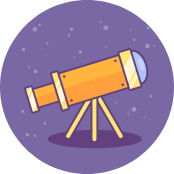
Learn More
Interested in learning more about astrophotography and the gear you'll need? Not sure where to begin? Check out our Astronomy Hub!
Glossary
Astronomy
Astronomy is the scientific study of space and the celestial objects within it. It also deals with the physical universe as a whole. Astronomy can be broken up into four subcategories: astrophysics, astrometry, astrogeology, and astrobiology. The study of astronomy has helped measure time, seasons, and navigation on Earth.
Astrophotography
This refers to photography of astronomical bodies and phenomena. Astrophotography is not new, for example the popular T threading still used today harkens from Tamron’s T-mount developed for their 35 mm cameras - however it has seen a notable increase in popularity with improvements in cameras, mounts, filters, and software making astrophotography much more accessible. This is not limited to celestial bodies such as nebulae, planets, or galaxies either, as solar imaging is now more within the reach of the average consumer than ever before.
Auto-Focus
Automatic focusing utilizes software to shift the focus of a telescope in and out to determine the precise focal point of the optics. It does this by reading the star size at each focus point, creating a graph of this data, then finds the minimum star size; bringing the optics into sharp focus.
Autoguiding
Autoguiding is a process which utilizes a smaller telescope, referred to as a guide scope, and an additional camera sensor, known as a guide camera, to assist your mount in its tracking precision. Alternatively, this can be achieved using an Off-Axis Guider (OAG), which is fitted within your primary imaging train. An OAG uses the light captured by your telescope and sends it to your guide camera via an internal prism. So, how does autoguiding actually work? Your guide camera will take a constant series of short exposures (typically 1-3 seconds each) that will then be analyzed by software. After the software selects the best guide star(s) to guide upon, the goal is to keep these stars as steady as possible from frame to frame. If there is a discrepancy in the positioning of the stars, the guiding software will communicate with the mount to make small adjustments to fix these tracking errors. While it may not be necessary for short exposure astrophotography such as planetary, lunar, or solar, autoguiding is highly beneficial for long exposure astrophotography.
Backfocus / Backfocal Distance / Backspacing
All optical systems have a point at which an in-focus image is formed, and for astrophotography it is at this location that the camera sensor should be placed. When the telescope is used without corrective elements, this is done easily with the focuser mechanism; and so long as an image can be brought into focus, optimal optical performance will be achieved. However with corrective elements, oftentimes there is a certain distance that the camera sensor needs to be placed away from the rear of the corrector for optimal performance. This will be listed as the backspacing or backfocal distance for the corrective element.
Bahtinov Mask
A Bahtinov mask is a tool that aids the user in finding optimal focus and was created by Russian astrophotographer Pavel Bahtinov in 2005. This type of focusing aid creates 3 diffraction spikes over a bright star within the field of view. While adjusting the focus knob, the point in which the three lines intersect perfectly over the star result in perfect focus. This tool is widely used by astrophotographers worldwide and creates an effortless focusing routine.
Color Camera / One-Shot-Color Cameras (OSC)
Often referred to as One-Shot-Color (OSC) cameras, these cameras are able to produce an image in full color without the use of additional filters. This greatly simplifies the imaging process, and allows astrophotographers to complete a project in far less amount of time. They are especially useful for those who have limited clear nights, where they can go weeks to months without having an imaging opportunity due to their climate. These cameras are excellent choices to image the planets, the Sun, the Moon, and deep space.
Corrective Element
This refers to an optical accessory such as a field flattener, coma corrector, or reducer. These improve some facet of a telescope’s performance, such as optical distortions that might otherwise appear on the edge of the frame; or augments it, for example by providing a wider field of view.
Dedicated Astronomy Camera
These cameras don’t look like what one traditionally thinks of when imaging a camera; instead taking the form of cylinders or pucks, with no physical controls, displays, or viewfinders to speak of. These require a computer or WiFi control device to take images, with more advanced models additionally requiring external power. What they give in return for all of these concessions is granular control over the sensor settings, increased sensitivity to wavelengths that more traditional cameras filter out, options for deBayered sensors (true monochrome), designs that easily connect with astronomy equipment, and in some cases cooling for increased performance.
DSLR / Mirrorless Camera
What one may consider a “regular” camera; used for everyday photography and feature an interchangeable (removable) lens system. Popular brands from this category that also enjoy wide support in the astrophotography hobby are Sony, Canon, and Nikon.
Finder Scope
A finder scope fits on top of the main telescope and is used to help you find and center objects in your eyepiece. A finder can be as simple as a red dot finder or it can be a high quality small telescope in its own right.
Focal Reducer
A focal reducer is an optical modifier that reduces the focal length of your telescope. These accessories come in a wide variety of reducing powers, and are typically dedicated for use with one specific telescope model. They are great options for those looking to widen their field of view without having to create complicated mosaics. Also, the use of a focal reducer increases the overall speed of the telescope, allowing more light to be collected in less time.
GPS
Originally invented by the U.S. Department of Defense, this technology became fully functional in the United States in 1995. This radio navigation system utilizes satellites to provide the precise global position of GPS enabled devices. Out of the 31 GPS satellites orbiting Earth today, GPS receivers only need information from 4 GPS satellites to determine accurate location. Cell phones, computers, and endless other devices act as GPS receivers. GPS is helpful in astronomy and astrophotography by providing the imaging software with the correct time, date, and location, helping create a detailed image of what the sky should look like based on this information.
Guide Camera
A guide camera has the important job of assisting your mount with its tracking capabilities. It does this by capturing constant frames of the night sky, usually 1-3 seconds each, that are then sent to autoguiding software. The software analyzes the field of view, selects guide stars and determines their center of mass, then compares each incoming frame to this calculated center of mass. If any discrepancies are found between the captured frames, the software will then communicate with the mount to fix these errors.
Imaging Train
Your imaging train is your telescope, camera, and any other accessories that are fixed between them, such as filters, filter wheels, off-axis guiders, focal reducers, etc.
Light Pollution
Light pollution is the brightening of the atmosphere due to lights from streetlamps, other forms of artificial light, and even the Moon. As light enters the atmosphere, it washes out the night sky, making it very difficult to observe the stars, nebulae, and planets. In order to combat light pollution in astrophotography, special filters have been developed to cut through excess light and enhance images. These filters are known as City Light Suppression filters, commonly referred to as CLS filters.
Monochrome Camera
Monochrome cameras deliver the most detail and sensitivity out of all other camera options. Color cameras have an arrangement of pixel filters in a 2x2 grid, typically consisting of two green, one red, and one blue, which is then repeated across the entire sensor in what is known as a Bayer pattern. Monochrome cameras however, have photosites that do not contain an alternating pattern of those red, green, and blue light pre-filters. Instead, their photosites collect all incoming light regardless of color – allowing for up to 3x the collection of signal (red, green, and blue light). Because the camera itself is not pre-filtering each color, in order to produce a full color image, they must be paired with filters to create a full color image. These filters can range from simple RGB filters to narrowband filters, and the collected data is then combined in a photo editing software. Though light is still passed through an external filter, every pixel well is utilized, resulting in 4x more red or blue signal and 2x more green signal compared to a color camera.
Nebula
A nebula is a type of celestial body that is made up of gas and/or dust. There are 3 different types of nebulae within space. Emission nebulae have a “glowing” effect, where they absorb and emit light from surrounding stars. The colors emitted are entirely dependent on the gasses present within the nebulae itself. This type of nebula also includes planetary nebula and supernova remnants, produced by stars themselves. As opposed to emitting light itself, reflection nebulae reflect starlight from neighboring stars. Reflection nebulae are typically blue in color, such as the Pleiades or the Running Man Nebula. The last type of nebulae is dark nebulae, which blocks stars and other objects from our view, creating a dark silhouette.
Nosepiece
An adapter that allows cameras to be installed in place of visual observing equipment such as diagonals or eyepieces. These adapters feature threading for a T-Ring or camera on one side, and an 1.25” or 2” barrel on the other.
Off-axis Guider (OAG)
As opposed to using a guide scope, off-axis guiders are fitted into the main imaging train itself, and utilizes the incoming light from the primary telescope for guiding. It achieves this via an internal prism that sends light into the guide camera. When using traditional guide scopes, these scopes can alter in position slightly through the night of imaging, causing the issue of differential flexure. But utilizing the main imaging rig’s incoming light, off-axis guiders eliminate this issue.
Plate Solving
The process of plate solving involves software analyzing a captured frame and comparing the star patterns to a database to determine the exact pointing position of the telescope. This procedure is incredibly helpful in Go-To processes, allowing the user to slew directly to the desired object with the click of a button.
Polar Alignment
Polar alignment is the process of aligning a telescope mount’s polar axis with the Earth’s axis of rotation. By having these two axes parallel to one another, precise counteraction of the Earth’s rotation can then be achieved. While a typical process of equatorial mounts that have three inherent axes of rotation, a similar effect can also be achieved by utilizing an equatorial wedge with two-axis alt-azimuth mounts.
Post-Processing
In order to complete an astroimage, it’s necessary to bring the captured frames into software to perform post process editing. This action varies for different types of astrophotography, though in general, it involves image stacking to reduce noise and remove artifacts, and image editing to enhance the captured detail and color.
Reflector Telescope / Reflecting Telescope
A reflector is a telescope design in which mirrors are used to gather and focus light. Reflector telescopes are commonly called Newtonian Reflectors, or simply a Newtonian in deference to their inventor, Sir Isaac Newton.
Refractor / Refracting Telescope
A refractor telescope is an optical instrument that utilizes refraction of light to create a visual image. This telescope type uses an objective lens to bend/refract light from far away objects to magnify them, as well as allowing them to appear brighter and clearer. Refractors were created in 1608, and their creation is attributed to Hans Lippershey, a Dutch lens maker.
Sky Atlas
Sky Atlas is a digital planetarium created by ZWO for their ASIAIR and Seestar platforms. Digital planetariums are representations of the night sky as it appears at a certain time and location, generally synchronized to those of the user. This allows users to look for objects to observe/ image, usually showing a visual representation and technical information about the targets. In more advanced planetariums like the Sky Atlas and those included in most other smart telescope apps, GoTo functionality will be included to slew the user's telescope to whichever section of the sky they desire.
Software
Software consists of programs and date used by a computer to complete certain tasks.
T-Adapter
Typically this is used to describe an accessory for SCT telescopes, which is threaded to the back of the OTA or reducer (replacing the visual back). These spacers add enough space to the imaging train such that only the industry standard 55 mm of backspacing remains. For information on the adapter that connects directly to a DSLR/ mirrorless camera, see T-Ring.
T-Ring
A T-Ring is an accessory that is used to connect a DSLR/ mirrorless camera to threaded connections. These have a camera lens mount on one side, and a female/ internally threaded connection on the other in either M48 or M42. Most (but not all) T-Rings will set the camera at 55 mm of backspacing, making connections easy.
Tracking
As the Earth is continuously spinning and in motion, the location of a celestial object in the sky moves over the course of a night. This becomes apparent during observation as a target moves out of view, and particularly observable in images as stars and objects quickly become a blur as exposure time and focal length increases. To compensate for this, computerized mounts and smart telescopes employ tracking techniques to keep the target centered in the optics. Depending on the motion style of the mount, the resulting image can vary. Alt-Az motion, popular in smart telescopes, keeps the object centered but can not compensate for its “spin” without what is known as a wedge. Accordingly these images lose information on the edges of the frame as they rotate out of view, leading to ever smaller, circular, images as time spent imaging increases.
USB
Universal Serial Bus or USB is a protocol for data transmission, and is by far and away the most common way astronomy equipment will communicate with a PC in a wired capacity. There are a number of USB connectors, such as USB-A (the rectangular port you’re likely familiar with), USB-B, USB-C, and micro USB; as well as a number of different revisions (2.0, 3.0, 3.1, etc.) that have brought more speed, power, and reliability to the protocol.
WiFi (Wi-Fi)
Wi-Fi, sometimes shortened to just WiFi or wifi, is a protocol for wireless communication. Primarily it is used to transmit and receive data between a device (such as a smartphone, computer, smart TV, and an ever increasing number of other household devices) and a router or wireless access point that is connected to the internet. Communication with the internet is not the only function the Wi-Fi protocol is useful for, and indeed many of the aforementioned devices can communicate with each other locally using this protocol and the router as an intermediary. Increasingly this protocol has been used for more direct communication between two devices (like a smartphone and a smart telescope), with one creating its own access point or broadcast that both devices then send and receive data on. While this does have the disadvantage of disconnecting a device’s connection to the internet, it has become necessary to transfer large amounts of data quickly that otherwise exceed what Bluetooth can accommodate.






